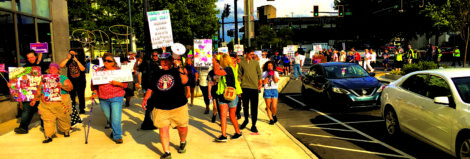Sojourn to the Past travels to learn about slavery’s history in US
Sojourn to the Past travels to learn about slavery’s history in US

From left, Mahoning Valley Sojourn to the Past members Brittany Bailey, Meri Johnston and Lekeila Houser close their eyes to reflect and touch a gentle waterfall at the National Memorial for Peace and Justice in Montgomery, Ala. The center honors the more than 4,400 black men, women and children who were lynched in the U.S. between 1877 and 1950. Correspondent photo / Sean Barron
MONTGOMERY, Ala. — When Brittany Bailey saw a jar containing nondescript dark brown soil on a wooden shelf, it took her back to a cold day in late 2019.
“The man was left for dust and nearly forgotten. I was happy to see the jar on the top shelf; I realized not everybody wants to keep it in the past, but we need to educate others on what happened so it will not happen again,” Bailey, a Mahoning Valley Sojourn to the Past member, explained.
She was referring Saturday to a jar of dirt that marked the location where a black man named William Taylor was lynched Sept. 4, 1878, in Sandusky. In November 2019, she and a few other STTP members collected the dirt from where Taylor was killed, and it is housed in The Legacy Museum in Montgomery.
The jar is one of about 320 filled with soil that were taken from lynching sites, mainly in the South, and are housed on eight shelves at the museum.
It also was the first stop for 19 students and adults who embarked Saturday on the annual Sojourn to the Past traveling American history course, which takes participants to many civil rights sites in the South and introduces them to people who fought nonviolently for social change in the country. The late congressman and civil rights icon John Lewis frequently spoke to Sojourn gatherings.
More than 4,400 black men, women and children were lynched in the U.S. between the end of Reconstruction in 1877 and 1950, according to Bryan Stevenson, an attorney and best-selling author who created the Equal Justice Initiative, which runs the museum and memorial. Besides hangings, lynchings include drownings, shootings, stabbings, beatings and burnings.
Bailey said the memorial was a solemn reminder of how too many blacks were killed for things for which they exerted no control — namely their skin color. She also recalled having seen a victim named James Bailey and wondered if she could be related to him, Bailey continued.
Before he was killed, Taylor had worked on a family barn in Sandusky when a white woman was found slain in the nearby home. Her blood was found in the barn, so it was automatically assumed Taylor had killed her, Penny Wells, Mahoning Valley Sojourn to the Past’s executive director, noted.
A mob took Taylor from the local sheriff and tried to hang him from a gazebo, but the rope broke, so he was hanged from a lamppost near downtown Sandusky without a trial, Wells added.
The Legacy Museum is a dramatic testimonial to slavery and the Jim Crow era in the U.S. Included is information and photographs that capture the domestic slave trade in which about 1 million blacks were forcibly moved to the Deep South between 1810 and 1860. They often were held in dungeons, jails, depots and warehouses until they were ready to be auctioned and sold, according to the EJI, a nonprofit organization that provides free representation to those who have been illegally convicted of a crime, unfairly sentenced or abused while incarcerated.
The memorial contains 837 ominous, rust-colored rectangular pillars that hang from various heights, each of which has inscribed the names of those lynched in a given county or northern state. Most occurred in Georgia, Alabama, Mississippi and Florida.
Besides Taylor, Ohio has had 15 such crimes dating to the late 1800s.
While on a bus ride from Montgomery to Birmingham, Ala., the students and adults shared their reflections on what most impacted them about having visited the museum and memorial.
Meri Johnston said she was shocked to learn that the incarceration rate for black women in the U.S. has risen 600 percent in the last 25 years.
A few others were moved by a haunting photograph of a 14- or 15-year-old boy crying while hugging his mother after learning he had been sentenced to death. Rather than overtly crying, however, the mother seemed tired and worn out with a look of resignation, as if she had assumed nothing was going to change, they observed.
Rylee Stanley, 17, said she was “mortified” to learn about the criminal intricacies of the slave trade, much of which took place in Montgomery in the 1800s.
“That, like, killed me,” she said, referring to a sign in the museum stating blacks, Mexicans and Puerto Ricans were to be excluded.
The sign was a disturbing reminder of how many people of color “were treated like garbage,” Rylee added.
Also Saturday, the participants received a driving tour of Montgomery that included the state capitol building, the Southern Poverty Law Center, a fountain in the location of a former slave market and the Dexter Avenue Baptist Church, where Dr. Martin Luther King Jr. had preached in the 1950s.
news@vindy.com




